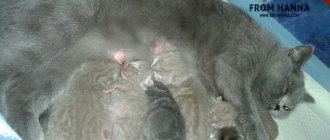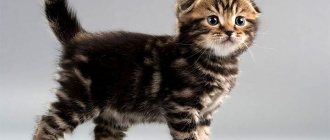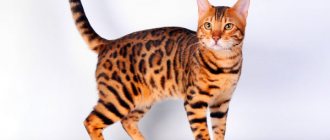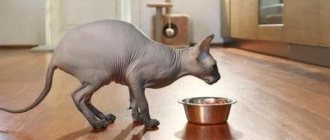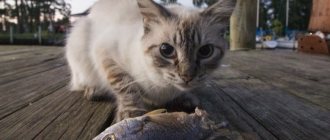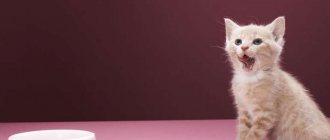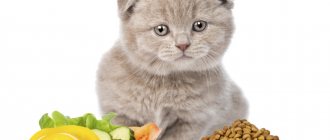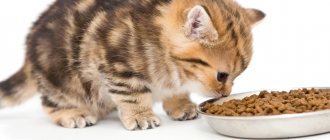Veterinarians recommend feeding your bobtail with natural meat and fish food that the animal could get in the wild. To replenish fiber and vitamins, your pet's menu includes porridge, fruits, vegetables and vegetable oils. Ready-made food can be a supplement to the main diet, for example, in winter, but does not replace fresh meat and fish.
General feeding rules
The Kurilian Bobtail has an increased appetite and energy expenditure, so if he stops asking for food, he should be seen by a veterinarian.
Felinologists recommend compiling a cat's daily diet based on the following principles of healthy eating:
- Preference is given to fresh, natural products that the pet could obtain in natural conditions.
- Feed the kitten up to 4 months. you need up to 6 times a day, then the frequency decreases to 2-3 meals. For an adult healthy cat, breakfast and dinner are enough.
- Caring for a cat includes monitoring the vitamins and minerals entering the body, which is why veterinarians recommend taking a preventive course of vitamin supplements once every 3-6 months. The dosage varies depending on the weight and age of the pet. Kittens especially need extra calcium.
- Up to ¾ of the cat’s menu consists of fish and meat products, supplemented by a small amount of cereals.
- Dry food is not recommended, as it is poorly digested by the predator’s stomach.
- Meat products can be given raw if you are sure of their high quality, but it is better to boil them. You should not vape as this increases the risk of fatal poisoning.
- A bobtail must always have grass and unstagnant water.
Return to contents
Origin story
How exactly the Kuril Bobtail breed appeared is still unknown. These cats first appeared on the Kuril Islands (hence the name) as a result of natural crossing of Japanese bobtails and Russian Siberian cats, which were brought to the islands by Russian merchants and fishermen. These agile animals with pom-pom tails have adapted well to the harsh climate: they have learned to excel at catching fish and rodents. Sometimes unusual cats were brought to the “mainland” as living souvenirs, but they became seriously interested in the breed only in the late 80s of the twentieth century.
Initially, felinologists did not distinguish between Japanese and Kuril bobtails, but later they noticed that the body structure, head shape and coat were significantly different from their Japanese relatives. In 1991, Moscow breeder Olga Mironova developed a breed standard, which was approved by the Soviet Feline Federation. And in 1994, the new breed was officially the world's specialists. Now there are more than a hundred Kuril Bobtail nurseries all over the world: loyal cats with an unusual appearance quickly won the love and respect of their owners.
Optimal menu: what can you feed?
Allowed types of meat
The most healthy products include low-fat varieties - meat from cows, bulls, young sheep, turkey or chicken. The sirloin should be finely chopped and served raw. By-products that are recommended to be given after cold treatment are also useful. Cow tripe is rich in vitamin complex and microorganisms, which improves the functioning of the gastrointestinal tract. It is also recommended to include beef liver that has undergone heat treatment in the diet, but no more than once every 4 days.
Small kittens up to 10 months are given boiled meat products, crushed to a mushy state. Daily feeding of meat to bobtails at a young age is contraindicated and can cause disruption of the functioning of the gastrointestinal tract. Kids eat liver, but it should be given in doses. Pork and lard are strictly prohibited.
Healthy fish and seafood
The Kurilian Bobtail must be fed with sea creatures. Fish that live in salt water do not need to be boiled, but the head should be separated, scales, bones and internal organs removed. White types of meat are best suited - pike perch, cod, monkfish and navaga. Fish from the river is also allowed, but must be boiled before serving. Healthy seafood includes shrimp, crayfish and squid. The frequency of consumption of fish products should not exceed 2 times every 7 days.
Milk and eggs
An adult bobtail cat usually loves boiled yolk, but it is allowed to be given no more than once every 4 days. The cat eats quail eggs completely, even raw. It is important to buy fermented milk products without additives, preferably from a farm. Recommended are kefir, milk, fermented baked sour cream, yogurt, and pure yogurt. Kittens should eat special cottage cheese with calcium, which you can buy at a pet store or prepare yourself. To do this, add 1 tsp to boiled milk. calcium salt of hydrochloric acid - CaCl₂. After sediment appears, the drink is filtered.
What kind of porridge can you eat?
Food for adult individuals will be oat grains that have sprouted, as well as buckwheat, oats, eggs and rice. This side dish is necessary to saturate the animal’s body with fiber. However, cereals must be cooked with milk. Rice cooked with plain water can cause difficulty in bowel movements. It is better to give babies milk semolina first, and only then the rest of the cereals. In the first weeks they should be with a minimum amount of oils and very liquid. From 5-6 months. You can carefully introduce buckwheat and oatmeal porridge into your diet.
Healthy fruits and vegetables
The animal's menu may include fresh or defrosted plant food, which will provide the vitamins the body needs. When choosing vegetables and fruits, you need to focus on your pet’s taste preferences. You should not force feed him. Typically, bobtails love finely chopped carrots, cabbage, zucchini, corn and sour apples. You should absolutely not give your pet avocados and citrus fruits. It is recommended to stew vegetables. You can add vegetable oils during the cooking process, but not spices.
Cat food
Eating dry pads and fresh meat or fish at the same meal will provoke pathologies of the gastrointestinal tract.
Only the highest quality food is suitable for the hunting breed - Royal Canin, Orijen, Pro Plan or Hill's. You can buy dry rations or wet canned food, but such meals should not be frequent. Nutritious dry mixtures from the economic line are strictly prohibited, as they can lead to allergies, pathology of the gastrointestinal tract and kidney failure. Whiskas and Kitty Kats are especially dangerous.
Cat food is not salted. Meat and meat by-products that are given raw must first be frozen. You cannot feed your kitten only meat and fish, or only cereals. You shouldn’t get carried away with fish at all; its excessive consumption leads to inflammatory kidney diseases and urolithiasis. Castrated animals should not be given fish at all. Food should be slightly warm or at room temperature. Do not give food that is too hot or cold (from the refrigerator). All food for the kitten is ground very finely, large and small bones are carefully removed. For an adult cat, food is cut into small pieces. Don't give big pieces! Raw meat is given in its pure form, cooked meat or fish (boiled) can be mixed with vegetables, cereals, etc.. Kitten 1.5-2 months. fed 5 times a day (or free access to food). By six months, gradually reduce the number of feedings to 3 times a day. From 8 months Feed like an adult cat 2 times a day.
Remember: a cat is a carnivore, and it does not have to eat borscht, pasta or coleslaw. A cat has its own special diet, and you should take this into account when feeding your pet, and not try to accustom it to what you and I eat - this is HARMFUL for cats and leads to various diseases.
Here is my method of feeding kittens for busy people.
For 1 kg of raw ground beef: 2 medium grated carrots (without nitrates), 200 g of kindergarten cheese (cheap, mild, unsalted), 1 raw chicken yolk (or 3 quail) for binding, a tablespoon of brewer's yeast (this is the entire group of B vitamins from B1 to B12), calcium gluconate (common chalk) - 6 tablets (put in a tablespoon, rub to powder form), vitamin D - 20 drops.
The amount of meat can be increased 2-5 times, correspondingly increasing the amount of other products.
Features of diet preparation
Each owner needs to immediately decide what to feed their pet and accustom it from childhood to a certain type of food, so that later they do not have to change it.
- Ready-made industrial feed . This is store-bought dry food or canned food. This type of food is as convenient as possible for the owners. The advantage of industrial feeds is that they have the most balanced composition, rich in vitamins and minerals.
- Natural nutrition is considered to be as close as possible to the natural diet of animals . The advantage of natural products is their variety of taste and the presence in them of a sufficient amount of substances beneficial to the animal. The disadvantage of natural food is that owners need to “tinker” with it, while every day preparing new dishes for their pet, subjecting the food to heat treatments.
- Mixed – alternation of industrial feeds and natural products.
Features of feeding bobtails. Veterinarians and breeders do not recommend keeping the Kurilian Bobtail on a mixed diet. The combination of different types of foods often leads to digestive disorders in children. The reason for this is an imbalance of carbohydrates, proteins and fats.
Creating a correct, balanced menu for Kuril Bobtail kittens is not an easy task. Despite their friendly disposition, representatives of the breed are particularly picky about their diet. If the kitten does not initially like the product, he will never eat it, no matter how useful and necessary it may be.
Character
The most pronounced features of the Kuril Bobtail
– this is attachment to people and a complete absence of aggression. These big bumpkins still retain their passion for fishing. They love water and find it everywhere. A bobtail is always not averse to a swim, and it can swim as well as a dog. By the way, bobtails are constantly compared to dogs; their behavior has too much in common.
In describing the character
of the Kurilian Bobtail,
one can often find mention of their constant need for communication. They can follow their owner for days, waiting to finally play with him. Usually cats of this breed choose one person in the family as the main one, but they will never offend other members either. Bobtails are especially tolerant of children, allowing them to do almost anything.
Another point in describing
the character of the Kuril Bobtail
breed is that bobtails master the entire household routine and way of life with incredible ease. They quickly get used to the designated area and litter tray. The only thing they need is a spacious room, as they love to jump and play.
Feeding with industrial feed
Ready-made food is the most popular type of food. This is convenient for the owners, as well as tasty and very healthy for the mustachios. To maintain the health of the Kuril Bobtail at the proper level, you need to choose expensive, high-quality commercial diets:
- Holistics - this type of industrial food for cats is the most expensive, but also the highest quality. Dry food of this class contains all the necessary vitamins and mineral elements in proportions that correspond to age and physiological standards. In addition to meat and cereals, the food contains probiotics, which have a positive effect on digestion processes. Recommended types of holistic treatments: Grandorf, Farmina.
- Super-premium food - a little lower in quality than holistic food, but a very good product that can be safely given to a Kuril Bobtail kitten. As a source of protein, these foods contain dried meat, vegetables, and sources of carbohydrates - wheat and rice. The food also contains dried fruits and berries. Recommended foods for Kurilian Bobtails are Fitmin, Savarra, Brit Care.
- Premium – the quality and cost of this category of feed is lower than that of the super-premium class. The product is healthy, tasty, and contains a balanced amount of vitamins and minerals. For a bobtail kitten, it is recommended to choose our brand, Sheba, Brit Premium.
Low-quality products are prohibited. Economy class feed is the lowest in quality. The main ingredient is corn, sometimes wheat. The source of protein is offal. Such products are not recommended for Kuril Bobtail babies. Otherwise, problems are possible not only with the digestive tract, but also with hair, vision, skin, etc.
Diet from natural products
Owners of growing small bobtails should understand one simple rule - feeding the kitten food from the common table is strictly prohibited. It is important to correctly and carefully select products for your pet so that they are healthy and of high quality. A natural diet may include:
- By-products – liver and kidneys. The liver has a positive effect on the digestive process, especially intestinal peristalsis. If your kitten is constipated, a piece of raw liver will help. Diarrhea can be eliminated with liver that has previously undergone heat treatment. The product can be boiled, baked or stewed. The kidneys must be soaked in cold water or scalded with boiling water. Heart – served to the kitten raw. Kurilian bobtail kittens are very fond of chicken, small hearts that do not need to be chopped with a knife.
- Dairy products : kefir, fermented baked milk, cottage cheese. Kids love to devour sour cream and cream, but the fat content of the products should not exceed 15%.
- Fish – mainly sea fish, frozen, served boiled or scalded with boiling water.
- Sources of fat are olive oil, add small amounts to other dishes. It is recommended to give your pet chicken or quail eggs from time to time.
- Cereals – buckwheat, oatmeal and rice. The volume of cereals per day is no more than 20% of the total amount of food.
- Vegetables – cauliflower and carrots.
- Fruits are provided upon request. You can do without them.
Each product, especially offal, has its own age restrictions. This must be taken into account when creating a menu for a small pet.
Prohibited natural products
- sweets, confectionery, chocolate;
- alcoholic and alcohol-containing products;
- some fruits - avocado, raisins, dried apricots, grapes;
- vegetables - garlic, legumes, tomatoes, potatoes;
- milk;
- spices;
- salts – strictly in limited quantities;
- baking, bakery products.
These products have an extremely negative effect on the condition of the kitten’s digestive system, causing stool problems and a number of diseases in adulthood.
Recommendations for natural nutrition
Natural products should be given to kittens carefully, observing age restrictions, food consistency and frequency of consumption of certain products:
- Porridge. For very small kittens, cereals can be boiled in milk, necessarily diluted with water (in equal proportions). It is not allowed to add any seasonings to porridge. The first porridges as complementary foods should be very liquid. As your pet develops and is able to eat more solid food, the porridge is gradually made thicker.
- Complementary feeding with fermented milk products begins with baby cottage cheese with a high calcium content. You can prepare the product yourself - bring the milk to a boil, add 1 tsp to it. calcium chloride. When flakes appear on the surface of the milk, the product is filtered.
- Fruits are optional, but vegetables should be on the menu regularly. Apple, cabbage or carrots are grated and can be seasoned with a small amount of vegetable oil, preferably olive oil.
Features of preparing and serving meat products. Meat, as a source of protein, should be the basis of the diet. But it is impossible to give it to a kitten thoughtlessly and in large quantities. In order not to harm your pet’s digestive system, you should adhere to a number of recommendations:
- The meat must be boiled first.
- Serving method: cut into small pieces, but it is preferable to give minced meat to kittens.
- Meat should not be the only product that your baby eats every day. Meat dishes must be alternated with others. It is not recommended to give your kitten meat every day, so as not to overload the digestive system.
- It is forbidden to give pork to kittens. The exception is pork offal with liver. But such a dish should be present in a pet’s diet extremely rarely.
- Turkey or chicken liver is allowed, but rare.
Following all the recommendations will help you create a correct, varied and balanced diet for your pet.
Meat delicacies
Adding meat products to your diet should be approached responsibly.
There are a number of “holy” truths that should be followed for the proper growth and development of the baby:
- Meat and fish products can only be given boiled.
- The serving should be small pieces, preferably in the form of minced meat.
- Under no circumstances should you give meat every day. Alternate foods.
- It is better to completely exclude pork from the menu, as well as liver and giblets.
- Chicken and turkey liver are allowed in limited quantities.
Menu for a Kurilian Bobtail kitten by month
Ideally, a kitten should be fed cat's milk for up to 1 month. But, unfortunately, this does not always happen. If the owner decides to feed the kitten commercial food, the product is selected according to the age label on the packaging. If the owner has opted for “natural” food, you should first consult with a veterinarian regarding the frequency and rules of feeding.
Complementary foods can be introduced no earlier than 3 weeks of age.
New food products are introduced gradually. Complementary feeding begins with meat. Preference should be given to rabbit or turkey. The meat must first be frozen, defrosted and cut into very small pieces before serving. In addition to meat, you can give your kitten low-fat cottage cheese, without any additives. Food given to the baby must be thoroughly crushed.
1 month
The main product in the diet of a month-old baby is lean meat of lean varieties. Approximate diet:
- meat, turkey, chicken or rabbit - in an amount of no more than 50 g per day;
- fermented baked milk;
- curdled milk;
- children's cottage cheese.
Quantity of fermented milk products – up to 15 g.
2 months
The total volume of food is from 150 to 180 g. Allowed products:
- lean meat – 60 g per day;
- cottage cheese, yogurt, fermented baked milk - about 70 g;
- boiled cereals: buckwheat, oatmeal or rice – 40 g;
- allowed vegetables – 20 g.
It is important to give your kitten vegetables and cereals from 2 months.
These products contain many vitamins and minerals necessary for the full development of the animal. The amount of cereals and vegetables from the total food volume should increase gradually.
Yummy
It’s not hard to guess that tasty things in our and cat’s understanding are very different things. For a cat, a treat can be a piece of delicious fish, fresh beef without veins, or, for example, a little of your favorite dry food. Of course, each owner decides for himself how and when to pamper his cat with treats.
We can only remind you that it is better to do this infrequently, not every day, and, of course, you should not feed your cat delicacies, much less sweets or cookies. Cats are capricious creatures; if they get used to treats, they can sabotage ordinary food and skillfully pretend that they are dying of hunger (Fig. 8).
Rice. 8. Kittens with an apple (Maxwell and Maggie)
Drinking regime
Regardless of the type of food - industrial or natural, it is important to maintain a drinking regime. The kitten's water needs to be changed every day. The Kurilian Bobtail drinks less than 250 ml of water per day. It is especially important to ensure sufficient water intake if your pet eats only dry products.
If a kitten drinks little water, you should find out the reasons for this phenomenon. Your baby may not like the bowl of liquid or the quality of the water. Insufficient fluid intake can lead to the development of a number of diseases of the digestive and urinary system in an adult cat.
Colors
Today, the recognized colors
of the Kuril Bobtail
are the following options:
- Red
- Cream
- Blue
- Black
- Tortoiseshell
- White
- Tortoise blue cream
If there is a white undercoat, the color is called silver or smoke, while the peach version is called amber or gold. Golden Kuril Bobtails look especially luxurious
This breed is allowed to have agouti color and various tabby patterns - marbled and spotted. The only option not recognized by the standard is color point. The black Kurilian bobtail has become popular recently
thanks to its unusually chic appearance.
Recommendations for organizing a place for eating
The dishes from which the newly purchased small bobtail will be fed must be of high quality and stable, have good capacity and high sides. Number of bowls – 2. One container is used for food, the second – water.
Materials for making dishes for kittens:
- Ceramics . The only drawback of ceramic bowls is their fragility. Kurilian Bobtails are lively and active kittens. They may play with the food bowl, pushing it away with their paw, causing it to break. Therefore, you need to choose a ceramic bowl with thick walls; it will have more weight, which will prevent it from rolling all over the floor. The advantage of using ceramics is high quality; such material will not impart an extraneous taste to food and water.
- Metal utensils are durable, reliable, and cannot be damaged, much less broken, by the paws of a moving kitten. In addition, stainless steel bowls are easy to clean.
- Plastic – the advantage of plastic bowls is their low cost. For kittens, it is recommended to choose plastic bowls with a special stand that will protect the floor from scattered food.
The depth of the dish depends on the type of food. If the kitten eats industrial food, you need to choose deep bowls with high sides for it. It is better to place natural products or liquid canned food in a shallow bowl.
Where is the best place to place the bowls? In the shared kitchen. Kurilian Bobtails are a very sociable breed of cats, and they will prefer to eat food with members of their household. You need to choose a place to place the bowls once and for all. It is not recommended to move the dishes further.
Caring for dishes. Of course, bowls should be washed regularly. However, you cannot use detergents for this. It is enough to treat them with hot water and a soft sponge.
Bowls should be washed daily.
Cat's temperament
Experts call this breed wonderful in every way. The Kurilian Bobtail is kind and friendly to all family members, loves affection and active games, is smart and inquisitive. But, cat owners note that with all the advantages in character, there are also disadvantages: they love independence and willfulness.
“Kuriles” are very careful creatures, they rarely go into the arms of strangers, it is necessary to find a special approach to the animal so that it “allows” to be friends with itself. Bobtails prefer to independently choose whom to be friends with and whom to avoid.
Cats from the Kuril Islands are sociable creatures that require constant attention from fidgets. Not everyone can withstand their energy, so if you like cats that are less persistent in communication, choose a breed with a calmer temperament.
The creatures have a sharp mind, are extremely inquisitive, and quickly adopt the skills of other animals living nearby. Experts believe that Kuril Bobtails are easy to train and can be easily taught funny tricks (it is especially easy to teach something if the training takes place in a playful way). This breed of cats, almost like dogs, are capable of bringing toys or a small ball thrown by a child. Especially favorite games are “hide and seek”, “catch” and “catch up”.
Contents in the apartment
Unfortunately, living in an apartment, this breed of “lynx” cannot express itself to its full potential. But once in nature, this cat is able to show all its talents. They love to hunt and fish, and do not feel afraid of water, forests or darkness. Be 100% sure that once in a familiar habitat, bobtails will show themselves in all their glory, and you will learn a lot of new, fun and good things about your pet.
In “apartment” life, this breed behaves peacefully and sociably. She is able to make friends with other inhabitants (if there are any). But the optimal communication for them is their brothers from the Kuril Islands and people. The following situation often occurs: a person got himself one bobtail, fell in love with him with all his soul for his affectionate and kind character, and then got several more individuals “for company.”
It is also necessary to remember that the “Kurilians” do not perfectly agree with all representatives of the animal world. Possessing the instinct of a hunter, these cats are not welcome in the proximity of hamsters or parrots - they will easily become the prey of a real hunter.
The originality of the Kurils is off the charts; they always want to live exclusively by their own rules. For this reason, experts recommend teaching cats to be orderly from the first days. Otherwise, there is a risk of becoming completely dependent on this animal, which imagines itself to be the rightful owner in the house.
It is quite problematic to retrain an adult with an already formed character. This will require a lot of effort and time; he almost never gives up the positions he has gained. If a cat sees that the situation is not to his taste, he begins to take revenge - this can manifest itself in different ways. Marking shoes and corners in the house, hanging on curtains and spilling food - this is not the whole list of “dirty tricks” that a bobtail can do.
If an animal is raised correctly, with affection and respect, problems will never arise.
Vitamins and minerals
The advantage of using ready-made commercial diets is that they already contain the necessary vitamins and minerals. There is no need to give them separately to your pet. But if a kitten eats natural products, it must additionally receive useful minerals. Recommended vitamins for Kurilian Bobtail kittens:
- Veda from Biorhythm, Russia . The vitamin complex is approved for kittens from the age of 2 months. Number of vitamins per day – 2 pcs. The package contains 2 types of tablets - morning and evening. The morning tablet contains substances that have a positive effect on the digestive and nervous systems and immunity. The composition of the tablet for evening use is substances intended to care for the animal’s fur: beauty and active growth. The course of taking the vitamin complex is 24 days. If necessary, the course is repeated after 7 days.
- Jimket, made in Germany . The package contains pink and green vitamins. Pink tablets contain fruit extracts, green tablets contain seaweed. The general composition of the complex includes all the substances necessary for a kitten. These are vitamins A, E, group B, K. Minerals: calcium, L-carnitine, taurine. Also contains nicotinic acid.
- Beafar, made in the Netherlands . The tablets have a pleasant smell that kittens really like. The composition is represented by vitamins PP, H and B. The complex is approved for use by animals aged 6 weeks and older. Vitamin dosage – 8 pcs. for every kg of body weight.
- Farmavit Active, Russia. The composition is represented by useful substances: vitamins A, B, E, H, mineral elements: phosphorus, calcium, taurine, rutin. The vitamin complex is useful because it helps improve digestion and replenishes the lack of nutrients in the gastrointestinal tract. The course of taking the complex is 30 days, after which you need to take a break of 6 to 8 weeks. Dosage – kittens under 3 months of age – ½ tablet, after 3 months – 1 tablet. per day.
Kittens that eat ready-made food should be given vitamins if they have health or coat problems.
Fluffy Kurilian Bobtail kittens are one of the cutest, active and friendly representatives of the cat world. In order for a pet to fully develop and enjoy good health, it needs to be provided with a complete and varied diet.
External standard
According to the accepted external standard, bobtails from the Kuril Islands must have the following characteristics:
The head is large with a wedge-shaped muzzle, narrowed at the bottom.
The eyes are medium in size, the upper part of the eye is oval, the lower part is rounded. Located from each other at a distance equal to the size of one eye. The color depends on the coat color; different colored eyes are possible.
The ears are medium in size, triangular in shape, ending in a slight curve. They have a distinctive feature - a slight forward tilt angle. Tassels are allowed on the ears.
The nose is medium in size, quite wide, straight in shape.
The bones and muscles are powerful and well developed.
The paws are rounded towards the bottom.
The coat can be presented in several options:
Short hair over the entire surface of the body with a medium-developed undercoat. It is soft, velvety to the touch, resembling the fur of exotic cats or British cats.
Semi-long coat with medium undercoat, forms fluffy pants, collar and socks. With this option, the tail should be very fluffy.
The tail might look like this:
Panicle. The tail consists of several vertebrae, according to the standard from 5 to 13, has creases and reaches a length of less than 14 cm.
Stump. A shortened tail of 2–8 motionlessly fused vertebrae reaches a length of approximately 5 cm.
Spiral. It is considered the most luxurious tail option. It is twisted in the form of a ring and can have a fairly decent length. The number of vertebrae ranges from 5 to 10.
The external standard must be strictly observed in the case of registration of a pedigree or participation in an exhibition.
